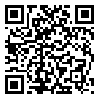Volume 23, Issue 1 (March 2025)
Iranian Rehabilitation Journal 2025, 23(1): 21-30 |
Back to browse issues page
Download citation:
BibTeX | RIS | EndNote | Medlars | ProCite | Reference Manager | RefWorks
Send citation to:



BibTeX | RIS | EndNote | Medlars | ProCite | Reference Manager | RefWorks
Send citation to:
Momeni A, Hatamizadeh N, Mehrkian S, Hosseinzadeh S. Experiences and Challenges of Educational-audiologists and Tele-rehabilitation During COVID-19. Iranian Rehabilitation Journal 2025; 23 (1) :21-30
URL: http://irj.uswr.ac.ir/article-1-2122-en.html
URL: http://irj.uswr.ac.ir/article-1-2122-en.html
1- Department of Rehabilitation Management, School of Rehabilitation Sciences,University of Social Welfare and Rehabilitation Sciences, Tehran, Iran.
2- Department of Clinical Medicine, School of Rehabilitation Sciences, University of Social Welfare and Rehabilitation Sciences, Tehran, Iran.
3- Department of Biostatistics, School of Public Health, Iran University of Medical Sciences, Tehran, Iran.
2- Department of Clinical Medicine, School of Rehabilitation Sciences, University of Social Welfare and Rehabilitation Sciences, Tehran, Iran.
3- Department of Biostatistics, School of Public Health, Iran University of Medical Sciences, Tehran, Iran.
Abstract: (3288 Views)
Objectives: This study aims to assess the status of hearing rehabilitation services for hearing-impaired students at schools during the COVID-19 pandemic in Iran.
Methods: This descriptive study included educational-audiologists all over Iran with at least 2 years of experience providing hearing rehabilitation services to students. Participants were asked to complete a web-based questionnaire regarding the provision of various hearing rehabilitation services, face-to-face, tele-rehabilitation, or both, as well as changes in the number of services provided during the pandemic. Twelve experts confirmed the face and content validity of the questionnaire (content validity index [CVI]=0.70). Participants who did not complete the questionnaire after three reminders were excluded. Data were analyzed using SPSS software, version 26. Phone interviews or video calls also asked about participants’ experiences and challenges in providing tele-rehabilitation and content analysis was used to analyze the data collected through interviews.
Results: Forty-three educational-audiologists participated in the study. Approximately one-third of audiologists provided parts of their services, such as tele-rehabilitation, in the form of individual or group online counseling sessions for parents, online auditory training sessions for recently cochlear-implanted or first and second-grade elementary school students, informal assessment of listening and communication skills by observing the child’s responses to the parent while performing listening skills exercises during video calls, providing parents with guidance to address problems with hearing aids and arranging for hearing aid repair services through mail carriers and couriers. The most challenging tele-audiology service was the formal assessment of hearing skills during the school year (score of 4.45, ranging from 0 to 7).
Discussion: It is mandatory to emphasize developing standardized tests for tele-assessment of children’s auditory skills. Sharing the experiences mentioned in the article among educational-audiologists and planners may help promote the use of tele-audiology services in pandemic situations, such as COVID-19, as well as improve the coverage of mainstream settings and schools far from cities.
Methods: This descriptive study included educational-audiologists all over Iran with at least 2 years of experience providing hearing rehabilitation services to students. Participants were asked to complete a web-based questionnaire regarding the provision of various hearing rehabilitation services, face-to-face, tele-rehabilitation, or both, as well as changes in the number of services provided during the pandemic. Twelve experts confirmed the face and content validity of the questionnaire (content validity index [CVI]=0.70). Participants who did not complete the questionnaire after three reminders were excluded. Data were analyzed using SPSS software, version 26. Phone interviews or video calls also asked about participants’ experiences and challenges in providing tele-rehabilitation and content analysis was used to analyze the data collected through interviews.
Results: Forty-three educational-audiologists participated in the study. Approximately one-third of audiologists provided parts of their services, such as tele-rehabilitation, in the form of individual or group online counseling sessions for parents, online auditory training sessions for recently cochlear-implanted or first and second-grade elementary school students, informal assessment of listening and communication skills by observing the child’s responses to the parent while performing listening skills exercises during video calls, providing parents with guidance to address problems with hearing aids and arranging for hearing aid repair services through mail carriers and couriers. The most challenging tele-audiology service was the formal assessment of hearing skills during the school year (score of 4.45, ranging from 0 to 7).
Discussion: It is mandatory to emphasize developing standardized tests for tele-assessment of children’s auditory skills. Sharing the experiences mentioned in the article among educational-audiologists and planners may help promote the use of tele-audiology services in pandemic situations, such as COVID-19, as well as improve the coverage of mainstream settings and schools far from cities.
Article type: Original Research Articles |
Subject:
Audiology
Received: 2023/11/1 | Accepted: 2024/05/1 | Published: 2025/03/1
Received: 2023/11/1 | Accepted: 2024/05/1 | Published: 2025/03/1
Send email to the article author








